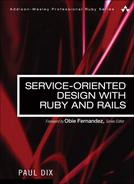Foreword
It’s an honor for me to present to you this timely new addition to the Professional Ruby Series, one that fills a crucially important gap in the ongoing evolution of all professional Rubyists and couldn’t come a moment sooner! It is authored by one of the brightest minds of our international Ruby community, Paul Dix, described as “genius” and “A-list” by his peers. Paul is no stranger to the Ruby world, a fixture at our conferences and involved in some of the earliest Rails project work dating back to 2005. He’s also the author of Typhoeus, a successful high-performance HTTP library that is an essential part of the service-oriented ecosystem in Ruby.
Why is this book so timely? Serious Ruby adoption in large companies and project settings inevitably necessitates service-oriented approaches to system design. Properly designed large applications, partitioned into cooperating services, can be far more agile than monolithic applications. Services make it easy to scale team size. As the code base of an application gets larger, it gets harder to introduce new developers to the project. When applications are split into services, developers can be assigned to a specific service or two. They only need to be familiar with their section of the application and the working groups can remain small and nimble.
There’s also the fact that we live in the age of The Programmable Web, the boom of web applications, APIs, and innovation over the past few years that is directly attributable to the rise of interoperable web services like those described in this book. Applications that rely on web resources present unique challenges for development teams. Service-oriented traits impact various aspects of how applications should be designed and the level of attention that needs to be paid to how the application performs and behaves if those services are unavailable or otherwise limited.
My own teams at Hashrocket have run into challenges where we could have used the knowledge in this book, both in our Twitter applications as well as our large client projects, some of which we have been working on for years. In a couple of notable cases, we have looked back in regret, wishing we had taken a service-oriented approach sooner. I assure you that this book will be on the required-reading list for all Rocketeers in the future.
Like Hashrocket, many of you buying this book already have big monolithic Rails applications in production. Like us, you might have concerns about how to migrate your existing work to a service-oriented architecture. Paul covers four different strategies for application partitioning in depth: Iteration Speed, Logical Function, Read/Write Frequency, and Join Frequency. Specific examples are used to explore the challenges and benefits of each strategy. The recurring case study is referred to often, to ensure the discussion is grounded in real, not imaginary or irrelevant situations.
Paul doesn’t limit himself to theory either, which makes this a well-rounded and practical book. He gives us important facts to consider when running in a production environment, from load balancing and caching to authentication, authorization, and encryption to blocking I/O to parallelism, and how to tackle these problems in Ruby 1.8, 1.9, Rubinius, and JRuby.
Overall, I’m proud to assure you that Paul has given us a very readable and useful book. It is accurate and current, bringing in Rack, Sinatra, and key features of Rails 3, such as its new routing and ActiveModel libraries. At the same time, the book achieves a timeless feeling, via its concise descriptions of service-oriented techniques and broadly applicable sample code that I’m sure will beautifully serve application architects and library authors alike for years to come.
—Obie Fernandez
Author of The Rails Way
Series Editor of the Addison-Wesley Professional Ruby Series
CEO & Founder of Hashrocket
